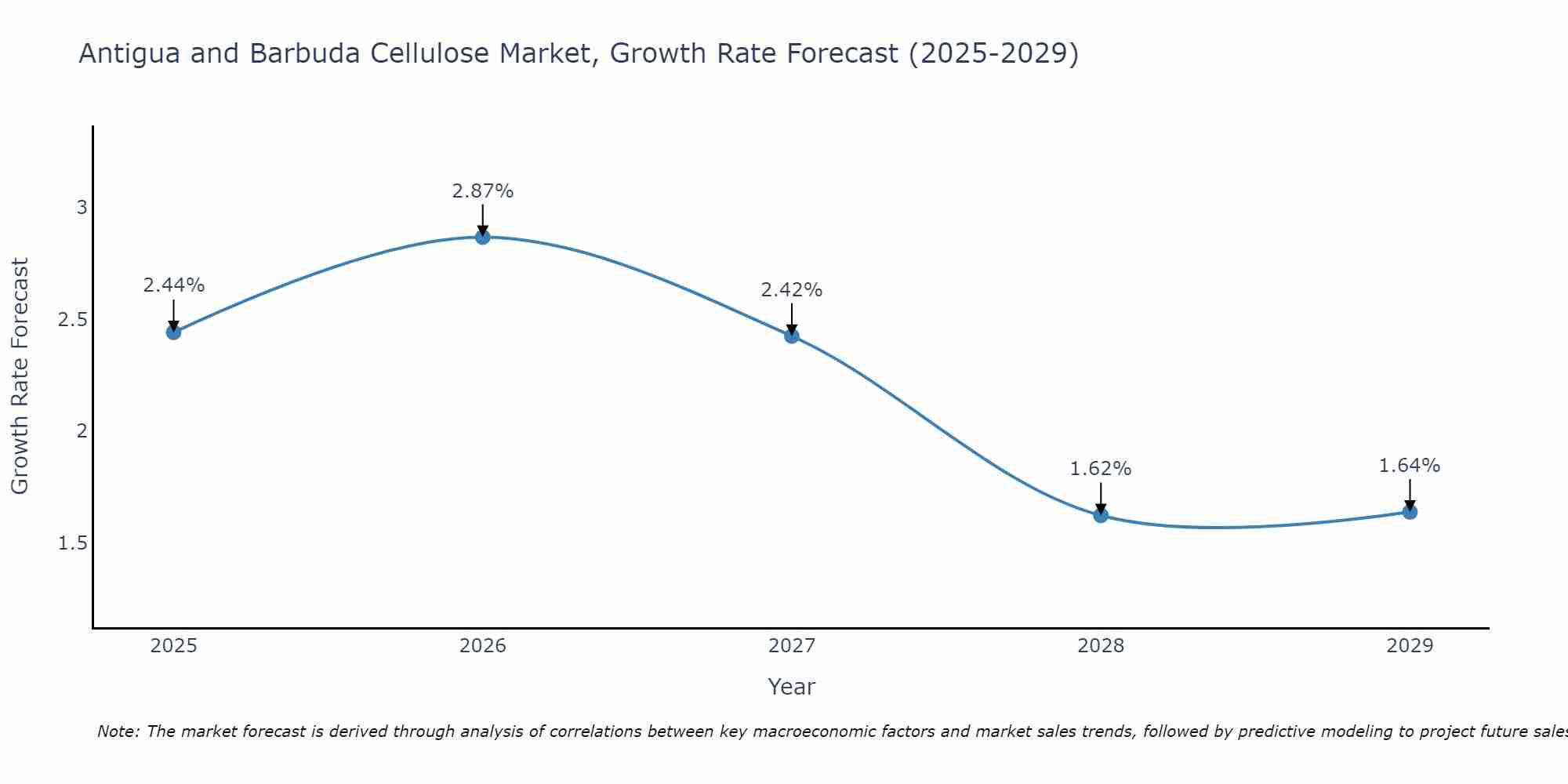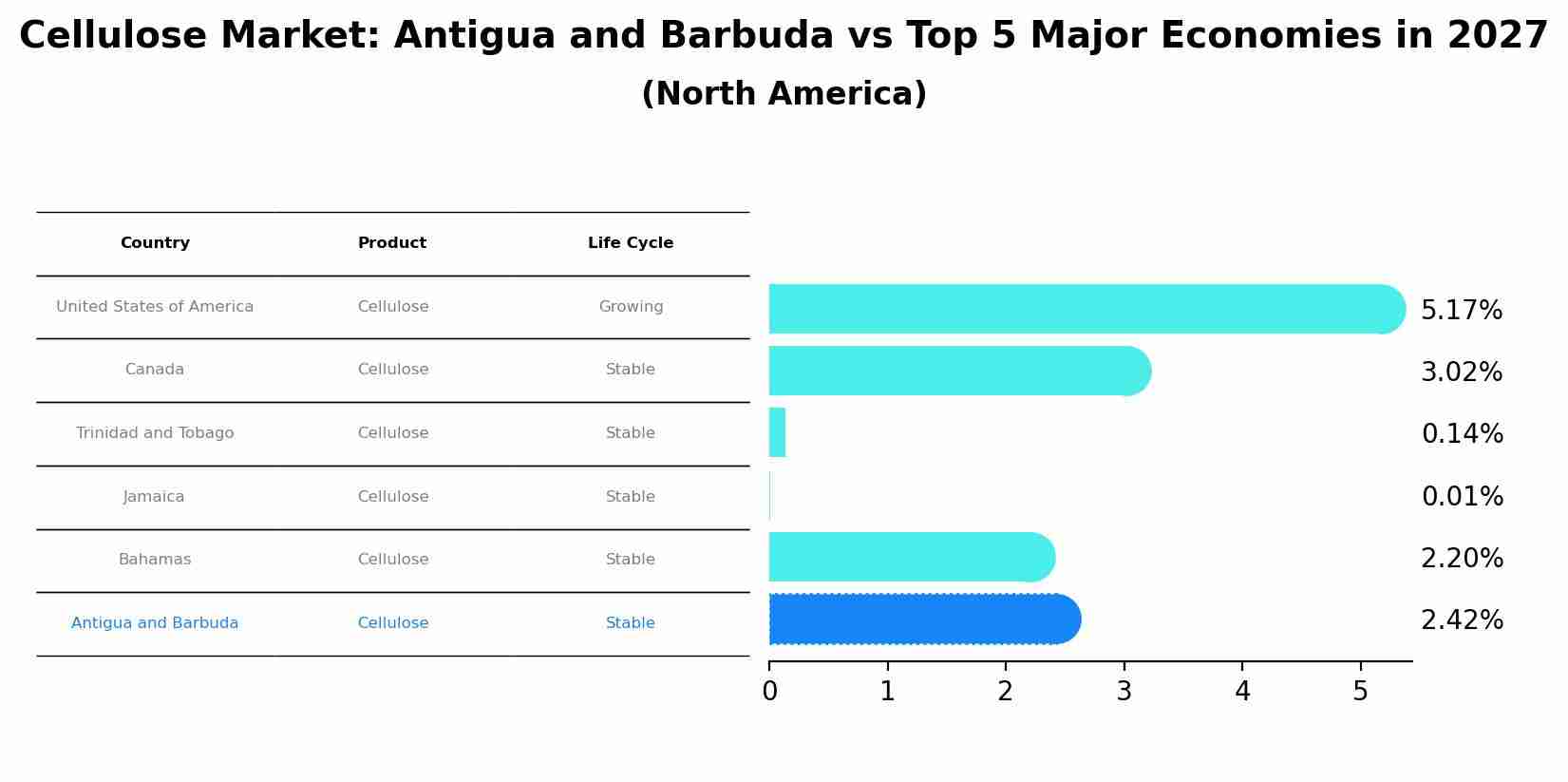Antigua and Barbuda Cellulose Market (2025-2031) | Analysis, Forecast, Industry, Size, Segmentation, Outlook, Trends, Growth, Value, Companies, Revenue & Share
| Product Code: ETC4661913 | Publication Date: Nov 2023 | Updated Date: Apr 2025 | Product Type: Market Research Report | |
| Publisher: 6Wresearch | Author: Shubham Deep | No. of Pages: 60 | No. of Figures: 30 | No. of Tables: 5 |
Antigua and Barbuda Cellulose Market Size Growth Rate
The Antigua and Barbuda Cellulose Market is projected to witness mixed growth rate patterns during 2025 to 2029. Starting at 2.44% in 2025, the market peaks at 2.87% in 2026, and settles at 1.64% by 2029.

Cellulose Market: Antigua and Barbuda vs Top 5 Major Economies in 2027 (North America)
The Cellulose market in Antigua and Barbuda is projected to grow at a stable growth rate of 2.42% by 2027, highlighting the country's increasing focus on advanced technologies within the North America region, where United States of America holds the dominant position, followed closely by Canada, Trinidad and Tobago, Jamaica and Bahamas, shaping overall regional demand.

Antigua and Barbuda Cellulose Market Oveview
The cellulose market in Antigua and Barbuda primarily caters to industries such as textiles, paper, and pharmaceuticals. The demand for cellulose is driven by its versatile applications, including use as a thickener, stabilizer, and emulsifier in food products, and as a binder and filler in pharmaceutical formulations. The market is influenced by the availability of raw materials, technological advancements, and regulatory frameworks governing the use of cellulose derivatives.
Drivers of the market
The cellulose market in Antigua and Barbuda is primarily driven by the rising demand for eco-friendly and sustainable materials. Cellulose, being a natural polymer, is extensively used in various industries such as textiles, pharmaceuticals, and food production. The shift towards sustainable and biodegradable products due to environmental concerns has further spurred its demand. Additionally, the growth in the construction industry, where cellulose is used for insulation purposes, also contributes to the market`s expansion.
Challenges of the market
The cellulose market in Antigua and Barbuda faces several challenges. One of the primary issues is the limited availability of raw materials necessary for cellulose production, which hampers local manufacturing capabilities and increases reliance on imports. Additionally, the market is constrained by a lack of advanced technology and infrastructure to process cellulose efficiently. The high cost of importing machinery and technology also poses a significant barrier to market growth. Moreover, there is a limited skilled workforce familiar with cellulose production techniques, which further impedes the market`s development.
Government Policy of the market
In Antigua and Barbuda, the cellulose market is influenced by various government policies aimed at promoting sustainable development and environmental conservation. The government encourages the use of biodegradable materials, which boosts the demand for cellulose-based products. Policies supporting the agricultural sector also contribute to the availability of raw materials for cellulose production. Additionally, import regulations and tariffs affect the market dynamics, with efforts to balance local production and importation to ensure market stability.
Key Highlights of the Report:
- Antigua and Barbuda Cellulose Market Outlook
- Market Size of Antigua and Barbuda Cellulose Market, 2024
- Forecast of Antigua and Barbuda Cellulose Market, 2031
- Historical Data and Forecast of Antigua and Barbuda Cellulose Revenues & Volume for the Period 2021-2031
- Antigua and Barbuda Cellulose Market Trend Evolution
- Antigua and Barbuda Cellulose Market Drivers and Challenges
- Antigua and Barbuda Cellulose Price Trends
- Antigua and Barbuda Cellulose Porter`s Five Forces
- Antigua and Barbuda Cellulose Industry Life Cycle
- Historical Data and Forecast of Antigua and Barbuda Cellulose Market Revenues & Volume By Fiber Type for the Period 2021-2031
- Historical Data and Forecast of Antigua and Barbuda Cellulose Market Revenues & Volume By Natural Cellulose Fibers for the Period 2021-2031
- Historical Data and Forecast of Antigua and Barbuda Cellulose Market Revenues & Volume By Man-made Cellulose Fibers for the Period 2021-2031
- Historical Data and Forecast of Antigua and Barbuda Cellulose Market Revenues & Volume By Applications for the Period 2021-2031
- Historical Data and Forecast of Antigua and Barbuda Cellulose Market Revenues & Volume By Apparel for the Period 2021-2031
- Historical Data and Forecast of Antigua and Barbuda Cellulose Market Revenues & Volume By Home Textile for the Period 2021-2031
- Historical Data and Forecast of Antigua and Barbuda Cellulose Market Revenues & Volume By Industrial for the Period 2021-2031
- Historical Data and Forecast of Antigua and Barbuda Cellulose Market Revenues & Volume By Others for the Period 2021-2031
- Antigua and Barbuda Cellulose Import Export Trade Statistics
- Market Opportunity Assessment By Fiber Type
- Market Opportunity Assessment By Applications
- Antigua and Barbuda Cellulose Top Companies Market Share
- Antigua and Barbuda Cellulose Competitive Benchmarking By Technical and Operational Parameters
- Antigua and Barbuda Cellulose Company Profiles
- Antigua and Barbuda Cellulose Key Strategic Recommendations
Frequently Asked Questions About the Market Study (FAQs):
1 Executive Summary |
2 Introduction |
2.1 Key Highlights of the Report |
2.2 Report Description |
2.3 Market Scope & Segmentation |
2.4 Research Methodology |
2.5 Assumptions |
3 Antigua and Barbuda Cellulose Market Overview |
3.1 Antigua and Barbuda Country Macro Economic Indicators |
3.2 Antigua and Barbuda Cellulose Market Revenues & Volume, 2021 & 2031F |
3.3 Antigua and Barbuda Cellulose Market - Industry Life Cycle |
3.4 Antigua and Barbuda Cellulose Market - Porter's Five Forces |
3.5 Antigua and Barbuda Cellulose Market Revenues & Volume Share, By Fiber Type, 2021 & 2031F |
3.6 Antigua and Barbuda Cellulose Market Revenues & Volume Share, By Applications, 2021 & 2031F |
4 Antigua and Barbuda Cellulose Market Dynamics |
4.1 Impact Analysis |
4.2 Market Drivers |
4.3 Market Restraints |
5 Antigua and Barbuda Cellulose Market Trends |
6 Antigua and Barbuda Cellulose Market Segmentations |
6.1 Antigua and Barbuda Cellulose Market, By Fiber Type |
6.1.1 Overview and Analysis |
6.1.2 Antigua and Barbuda Cellulose Market Revenues & Volume, By Natural Cellulose Fibers, 2021-2031F |
6.1.3 Antigua and Barbuda Cellulose Market Revenues & Volume, By Man-made Cellulose Fibers, 2021-2031F |
6.2 Antigua and Barbuda Cellulose Market, By Applications |
6.2.1 Overview and Analysis |
6.2.2 Antigua and Barbuda Cellulose Market Revenues & Volume, By Apparel, 2021-2031F |
6.2.3 Antigua and Barbuda Cellulose Market Revenues & Volume, By Home Textile, 2021-2031F |
6.2.4 Antigua and Barbuda Cellulose Market Revenues & Volume, By Industrial, 2021-2031F |
6.2.5 Antigua and Barbuda Cellulose Market Revenues & Volume, By Others, 2021-2031F |
7 Antigua and Barbuda Cellulose Market Import-Export Trade Statistics |
7.1 Antigua and Barbuda Cellulose Market Export to Major Countries |
7.2 Antigua and Barbuda Cellulose Market Imports from Major Countries |
8 Antigua and Barbuda Cellulose Market Key Performance Indicators |
9 Antigua and Barbuda Cellulose Market - Opportunity Assessment |
9.1 Antigua and Barbuda Cellulose Market Opportunity Assessment, By Fiber Type, 2021 & 2031F |
9.2 Antigua and Barbuda Cellulose Market Opportunity Assessment, By Applications, 2021 & 2031F |
10 Antigua and Barbuda Cellulose Market - Competitive Landscape |
10.1 Antigua and Barbuda Cellulose Market Revenue Share, By Companies, 2024 |
10.2 Antigua and Barbuda Cellulose Market Competitive Benchmarking, By Operating and Technical Parameters |
11 Company Profiles |
12 Recommendations | 13 Disclaimer |
- Single User License$ 1,995
- Department License$ 2,400
- Site License$ 3,120
- Global License$ 3,795
Search
Thought Leadership and Analyst Meet
Our Clients
Related Reports
- Germany Breakfast Food Market (2026-2032) | Industry, Share, Growth, Size, Companies, Value, Analysis, Revenue, Trends, Forecast & Outlook
- Australia Briquette Market (2025-2031) | Growth, Size, Revenue, Forecast, Analysis, Trends, Value, Share, Industry & Companies
- Vietnam System Integrator Market (2025-2031) | Size, Companies, Analysis, Industry, Value, Forecast, Growth, Trends, Revenue & Share
- ASEAN and Thailand Brain Health Supplements Market (2025-2031) | Strategy, Consumer Insights, Analysis, Investment Trends, Opportunities, Growth, Size, Share, Industry, Revenue, Segments, Value, Segmentation, Supply, Forecast, Restraints, Outlook, Competition, Drivers, Trends, Demand, Pricing Analysis, Competitive, Strategic Insights, Companies, Challenges
- ASEAN Bearings Market (2025-2031) | Strategy, Consumer Insights, Analysis, Investment Trends, Opportunities, Growth, Size, Share, Industry, Revenue, Segments, Value, Segmentation, Supply, Forecast, Restraints, Outlook, Competition, Drivers, Trends, Demand, Pricing Analysis, Competitive, Strategic Insights, Companies, Challenges
- Europe Flooring Market (2025-2031) | Outlook, Share, Industry, Trends, Forecast, Companies, Revenue, Size, Analysis, Growth & Value
- Saudi Arabia Manlift Market (2025-2031) | Outlook, Size, Growth, Trends, Companies, Industry, Revenue, Value, Share, Forecast & Analysis
- Uganda Excavator, Crane, and Wheel Loaders Market (2025-2031) | Strategy, Consumer Insights, Analysis, Investment Trends, Opportunities, Growth, Size, Share, Industry, Revenue, Segments, Value, Segmentation, Supply, Forecast, Restraints, Outlook, Competition, Drivers, Trends, Demand, Pricing Analysis, Competitive, Strategic Insights, Companies, Challenges
- Rwanda Excavator, Crane, and Wheel Loaders Market (2025-2031) | Strategy, Consumer Insights, Analysis, Investment Trends, Opportunities, Growth, Size, Share, Industry, Revenue, Segments, Value, Segmentation, Supply, Forecast, Restraints, Outlook, Competition, Drivers, Trends, Demand, Pricing Analysis, Competitive, Strategic Insights, Companies, Challenges
- Kenya Excavator, Crane, and Wheel Loaders Market (2025-2031) | Strategy, Consumer Insights, Analysis, Investment Trends, Opportunities, Growth, Size, Share, Industry, Revenue, Segments, Value, Segmentation, Supply, Forecast, Restraints, Outlook, Competition, Drivers, Trends, Demand, Pricing Analysis, Competitive, Strategic Insights, Companies, Challenges
Industry Events and Analyst Meet
Whitepaper
- Middle East & Africa Commercial Security Market Click here to view more.
- Middle East & Africa Fire Safety Systems & Equipment Market Click here to view more.
- GCC Drone Market Click here to view more.
- Middle East Lighting Fixture Market Click here to view more.
- GCC Physical & Perimeter Security Market Click here to view more.
6WResearch In News
- Doha a strategic location for EV manufacturing hub: IPA Qatar
- Demand for luxury TVs surging in the GCC, says Samsung
- Empowering Growth: The Thriving Journey of Bangladesh’s Cable Industry
- Demand for luxury TVs surging in the GCC, says Samsung
- Video call with a traditional healer? Once unthinkable, it’s now common in South Africa
- Intelligent Buildings To Smooth GCC’s Path To Net Zero


















